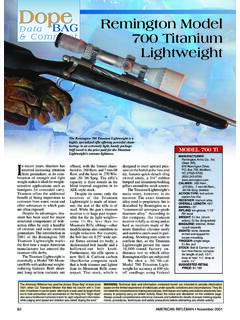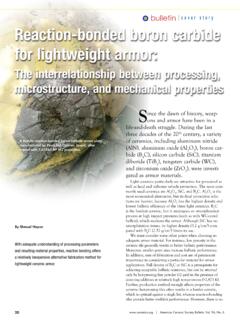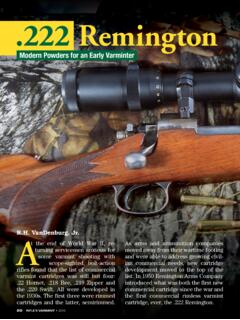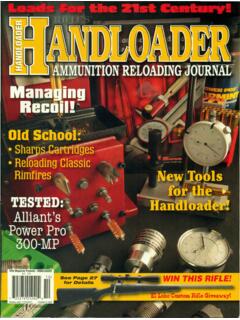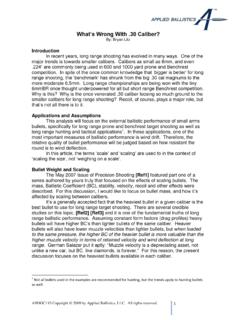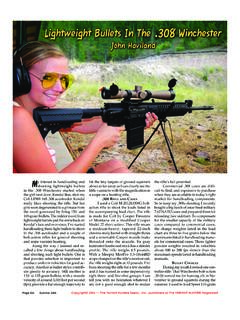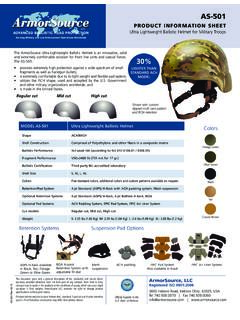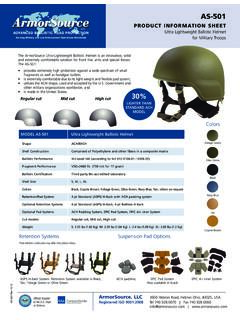Transcription of One-Shot Drops Surviving the Myth By ANTHONY J. …
1 One-Shot Drops Surviving the Myth By ANTHONY J. PINIZZOTTO, , HARRY A. KERN, , and EDWARD F. DAVIS, On a summer evening in the northeastern part of the United States, a patrol officer received a radio dispatch at approximately 7 to respond to an address for a disorderly subject. The officer arrived at the location and parked his patrol vehicle on the opposite side of the street, several houses away. Before exiting the vehicle, the officer paused to observe the scene. He saw a male move from behind a large tree in front of the address of the alleged disorderly subject. The officer started to exit his vehicle, but then stopped when he saw the male, with a gun in each hand, begin to run toward him. The man fired both weapons at the officer, who returned two rounds from his service weapon, striking the male in the center of his chest. However, the man continued to fire. One round struck the officer in the head, killing him instantly.
2 The male survived the two gunshot wounds and later was convicted of killing the officer. This scenario is a collage of several cases dealing with the use of deadly force, by and against law enforcement, that the authors have examined over the last decade. Studying these cases and interacting with officers attending the FBI National Academy,1who have experienced similar incidents in their own agencies, have led them to question if officers have died because of any of the following factors: zThe type of weapon issued to the officer. zThe type of ammunition the department issued for service rounds. zThe lack or quality of self-defensive training provided to the officer. zOverconfidence because the officer was wearing a bullet -resistant vest and, thereby, took unnecessary chances. zThe officer s own preparation for a violent encounter, such as wearing a bullet -resistant vest or remaining in excellent physical condition. zThe officer s choice to notify dispatch of the location during a traffic stop or other encounter with suspects.
3 Zny other circumstances presently unknown to the officer s department. Page 1 of 9 Federal Bureau of Investigation Law Enforcement Bulletin - October 2004 Issue1/10/2005 the opening scenario, did the officer hesitate after firing the two rounds that struck the offender? Was he instructed to double tap and pause, as many departments once trained? The authors have learned from their research on law enforcement safety that there exists a significant hesitancy on the part of many officers to use deadly force. However, they have not determined the reason for either the hesitation or why officers stop shooting before they neutralize the threat. One question they can answer is that handguns used for protection by law enforcement are capable of immediately eliminating a deadly threat quickly. However, the fact largely remains that bullet placement, rather than caliber, causes immediate stop-page of body functions in most instances. 2 With all of this in mind, then, if officers are adequately armed, what causes them to fall victim to criminals wielding less powerful weapons?
4 An examination of the myth of the One-Shot drop , data relative to the type of weapons offenders have used to attack officers, and effective survival and firearms training may help law enforcement agencies begin to reverse this tragic trend. Dr. Pinizzotto is the senior scientist and clinical forensic psychologist in the Behavioral Science Unit at the FBI Academy. Special Agent Kern serves in the Behavioral Science Unit at the FBI Academy. Page 2 of 9 Federal Bureau of Investigation Law Enforcement Bulletin - October 2004 Issue1/10/2005 Mr. Davis is an instructor in the Behavioral Science Unit at the FBI Academy. THE MYTH In many of the classic, albeit simplistic, cowboy movies from the early days of the American film industry, the stereotypical good guys wore white hats, whereas the bad guys donned black ones. After meeting in the middle of a dirt street in some small town, two shots would ring out. The bad guy s bullet always missed, but the one from the hero in the white hat inevitably found its mark and freed the town of the criminal threat.
5 With one shot from the good guy s gun, the bad guy immediately dropped to the ground and became completely incapacitated. In today s films and television programs, Hollywood has varied not only the clothing of the actors but also their standards and demeanor, both the good guys and the bad guys. It now has become difficult to distinguish the protagonist from the antagonist. Unfortunately, however, this increased realism has not always carried over to the portrayal of gun battles. Many current shooting scenes continue to display unrealistic reactions and underlying expectations regarding ballistic effects. For example, one shot from a handgun often lifts the wounded person 2 feet off the ground and causes immediate incapacitation. Even knowing that these are movies and television programs, some in the law enforcement community still expect One-Shot Drops in real-life shootings. In fact, few actual instances end this way.
6 Realistic and regular law enforcement training must counterbalance and mentally and emotionally override the fallacy of the One-Shot drop still promoted by some media. Short of disrupting the brain or severing the upper spinal column, immediate incapacitation does not Therefore, the threat remains to the officer. Yet, implicit in the media presentations of law enforcement encounters is the belief that with the proper handgun and the proper ammunition, officers will inflict immediate incapacitation if they shoot offenders anywhere in the torso. Varied and multiple real-life law enforcement experiences contradict this false and dangerous belief. Actual Shootings In the authors ongoing study of violence against law enforcement officers, they have examined Page 3 of 9 Federal Bureau of Investigation Law Enforcement Bulletin - October 2004 Issue1/10/2005 cases where officers used large-caliber hand guns with limited effect displayed by the offenders.
7 In one case, the subject attacked the officer with a knife. The officer shot the individual four times in the chest; then, his weapon malfunctioned. The offender continued to walk toward the officer. After the officer cleared his weapon, he fired again and struck the subject in the chest. Only then did the offender drop the knife. This individual was hit five times with 230-grain, .45-caliber hollow-point ammunition and never fell to the ground. The offender later stated, The wounds felt like bee stings. In another case, officers fired six .40-caliber, hollow-point rounds at a subject who pointed a gun at them. Each of the six rounds hit the individual with no visible effect. The seventh round severed his spinal cord, and the offender fell to the ground, dropping his weapon. This entire firefight was captured by several officers in-car video cameras. In a final case, the subject shot the victim officer in the chest with a handgun and fled.
8 The officer, wearing a bullet -resistant vest, returned gunfire. The officer s partner observed the incident and also fired at the offender. Subsequent investigation determined that the individual was hit 13 times and, yet, ran several blocks to a gang member s house. He later said, I was so scared by all those shots; it sounded like the Fourth of July. Again, according to the subject, his wounds only started to hurt when I woke up in the hospital. The officers had used 9-millimeter, department-issued ammunition. The Surviving officers re ported that they felt vulnerable. They wondered if they had done some thing wrong that caused their injury or placed them in the proximity of physical danger. They also wondered if they would react differently if faced with a similar situation. Practical Expectations Social science discloses that if people expect to see something, they well may see it. For ex ample, in basic psychology courses, instructors generally include the perceptual set theory, which shows students a picture.
9 Although exactly the same picture, it appears to some as an old woman, whereas others see a young woman. People often see what they expect to see. This explains why so many sightings of the Loch Ness monster turn out to be floating logs. Officers expectations of how they will respond when shot significantly affect their reactions to these situations. Development of advanced, practical expectations may be influenced best by clarifying misconceptions and imparting new knowledge during purpose-driven training concerning the topic. Absent a clear, purposeful understanding of the session s training objectives, little influential and practical learning can occur. Further, lack of purposeful training may prove detrimental to an officer s practical expectations, psychological preparation, and capabilities when employing complex tasks in response to the significant stressors of a life-threatening, critical incident. Humans are largely differentiated from animals through their miraculous ability to develop skills and abilities to perform multiple, complex tasks simultaneously through repetitive practice.
10 By necessity of minimizing risk to themselves and others, officers effectively learn many firearm-use procedures and tactics through a progressive building-block process. Herein, initial exposure is given to learning gross and fine motor skills. Some conscious behaviors develop into subconscious ones. Officers progressively hone skills to a reasonable level of mastery, then apply them under shorter time constraints during which they must incorporate and maintain mental processes of assessing their surroundings and changing conditions. Trainers need to remain cognizant of the role that repetition plays in the mental processes reinforced during training scenarios and courses of fire. From learners perspectives, ideal firearms and tactics training objectives should embrace an achievable notion that they will learn something new Page 4 of 9 Federal Bureau of Investigation Law Enforcement Bulletin - October 2004 Issue1/10/2005 their personal performances, skill levels, and capabilities with their equipment each time they receive training.
